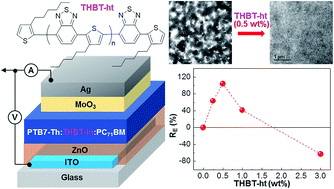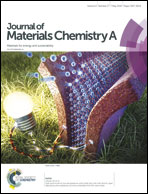Strong addition effect of n-type polymer with mid-energy level in polymer:fullerene solar cells with power conversion efficiency exceeding 10%†
Abstract
Here we report a strong addition effect of n-type conjugated polymer, which has a middle energy level between electron-donating polymers and electron-accepting fullerenes, on the enhanced power conversion efficiency (PCE) of inverted-type organic solar cells with bulk heterojunction (BHJ) layers of poly[4,8-bis(5-(2-ethylhexyl)thiophen-2-yl)benzo[1,2-b:4,5-b′]dithiophene-co-3-fluorothieno[3,4-b]thiophene-2-carboxylate] (PTB7-Th) and [6,6]-phenyl C71 butyric acid methyl ester (PC71BM). As a mid-energy level additive, poly(3-hexylthiophene-co-benzothiadiazole) end-capped with hexylthiophene (THBT-ht) was employed by varying its content up to 3 wt%. Results showed that the PCE of inverted-type PTB7-Th:PC71BM solar cells was enhanced from 8.77% to 9.81% (max: 10.02%) by adding only 0.5 wt% (1.47 mol%) THBT-ht. The pronounced improvement at 0.5 wt% has been assigned to the balanced charge transport and the drastic change of nanoscale morphology toward finer phase segregation and less hydrophobic smoother surface. The present finding is expected to contribute to further efficiency improvement of BHJ-based organic solar cells with various types of material systems.



 Please wait while we load your content...
Please wait while we load your content...